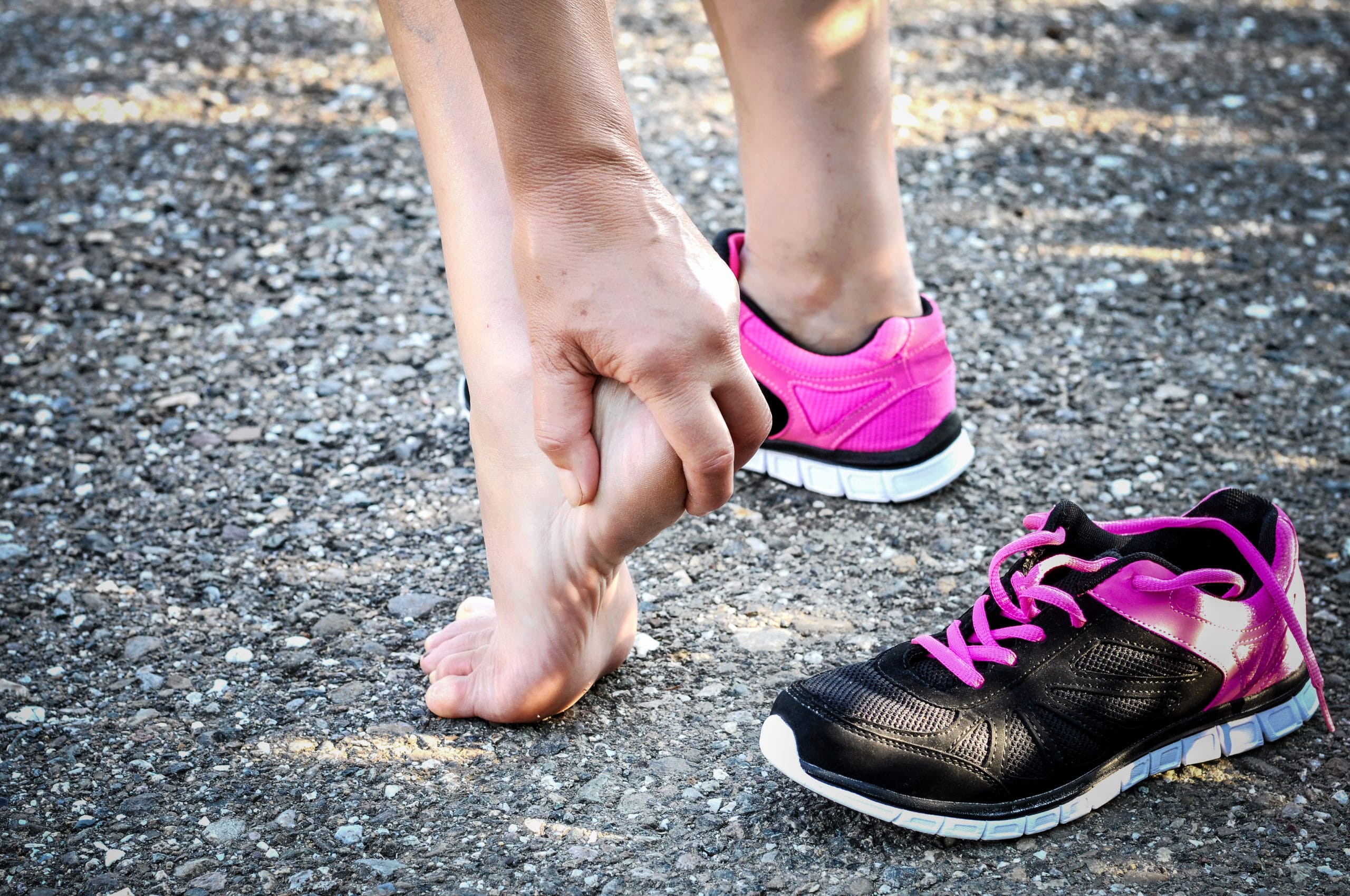Heel pain is a very common phenomenon for adults. If you feel mild to severe pain underneath your heel, or directly behind it, you most likely have some form of Plantar Fasciitis.
Plantar Fasciitis is one of the most common causes of foot pain affecting as much as 10 percent of the population. Every year 2 million Americans get treated for plantar fasciitis. If you are one of the millions who suffer from plantar fasciitis, you’re not alone.
Check if your heel pain is from Plantar Fasciitis first, then look at our guide on how to treat them for immediate relief.
Should I Use Heat or Ice for Plantar Fasciitis?
Ice is the best method for reducing inflammation from Plantar Fasciitis. While contrast baths between hot and cold water can also help, many people experience poor results with heat therapy alone. It is best to end your heat therapy with soaking in cold water.
You’ve probably heard about this before. When your muscles are sore, or you have an injury, you’re supposed to use ice packs and heat pads to help soothe them.
But is that the case for every muscle and joint injury? Plantar Fasciitis is caused by tears and stress to the plantar fascia, a thick ligament that connects the back of your heel to your toes.
Ligaments are very different from muscles, and thus they require a different treatment when they are injured. Muscles connect our joints and bones with the help of tendons. On the other hand, ligaments attach bone-to-bone with nothing in between.
Stronger muscles around the ligaments can help to prevent injuries, but it can be hard to strengthen the ligament itself. So back to the question of cold therapy vs. heat therapy for Plantar Fasciitis:
If you have an acute injury, you’ll want to use cold therapy. If you have a chronic injury, then you’ll want to use heat therapy to treat your Plantar Fasciitis.
Related: Best Accessories for Plantar Fasciitis
Cold Therapy for Plantar Fasciitis
When you apply an ice pack to an area of your body, it restricts the blood flow to that area. Your blood vessels shrink, your nerves become numb, and it generally reduces swelling and pain.
Swelling is caused by an excess of blood flow to an injured area, which typically leads to more pain around the injury.
How to use ice for your Plantar Fasciitis
There’s a little more to it than just slapping an ice pack onto your ankle and calling it a day. To get the fullest effect of icing your injury, you’ll want to pair it with rest, elevation, and compression if you have a good pair of compression socks.
This combination will help reduce overall swelling and pain, and hopefully shorten your recovery time. Here are some tips to help you while using an ice pack:
- Always use a barrier between your skin and the ice pack. You don’t want it to be in direct contact with your skin. A dishtowel works perfectly for this.
- To give your injury a little compression, you can use a cold wrap, or a tightly wrapped towel around your ankle to keep the ice pack firmly pressed to your injury. Some companies make specially design ankle ice packs just for this purpose.
- Keep your foot elevated at or above your heart. Lay down and prop your foot up on one or two pillows to help keep swelling to a minimum.
- Use the ice pack for 15 minutes, then remove it. Do this a few times, making sure to give your leg a proper break from the ice pack every 15 minutes.
You can also try pairing your ice pack usage with a massage for your foot! Stretching and massage can be a great way to help loosen up your injured ligament, as well as the surrounding muscles and tendons. You can do this using just a frozen plastic water bottle.
- Use a disposable plastic water bottle and fill it three-quarters full of water.
- Take the cap off and put it in the freezer. (Removing the cap allows the bottle to freeze more evenly).
- After the bottle freezes completely, put the cap back on and remove the bottle from the freezer.
- Sit down in a chair and place the frozen bottle on its side on the ground.
- Using a nice, gentle pressure, roll your foot over the bottle. Make sure to go all the way to the back of your heel to fully massage the plantar fascia. For best results, do this twice a day for just 10 minutes at a time.
What if I don’t have time for ice and a massage?
Time may not always allow you to use each of the techniques listed above. Here are a few times when it is crucial to ice, even if you don’t have time for a long session of recovery.
- After strenuous exercise
Icing your foot after a workout is very important if you’re having flare-ups of Plantar Fasciitis. After a long run or a particularly heavy workout, your plantar fascia may be overly stressed. Icing it will help you to recover quickly and reduce the chance of swelling.
- Before bed
If you’re having a rather painful flare-up of Plantar Fasciitis, using ice can help to numb the nerves and reduce your foot pain. If you find that ice isn’t helping, you can always try an over-the-counter medicine to help reduce pain and swelling.
Heat Therapy for Plantar Fasciitis
We have discussed on how to use cold therapy for Acute Plantar Fasciitis. But what about Chronic Plantar Fasciitis? Acute Plantar Fasciitis is caused by an injury to the plantar fascia. Chronic Plantar Fasciitis has no specific cause and tends to get worse over time.
Unfortunately, Chronic Plantar Fasciitis is more of a degenerative condition than the acute variety. It’s caused by everyday stress on the plantar fascia. Poor flexibility of the Achilles tendon and the calf muscle can be contributing factors as well.
Heat therapy can play a big part in reducing the risk factors and managing Chronic Plantar Fasciitis. When you apply heat to an injury, it widens your blood vessels and allows more blood to flow into the injury.
You need to be careful not to overdo it while using a heating pad. Too much heat can lead to an increase in swelling.
How to use heat for your Chronic Plantar Fasciitis
Using heat on an injury looks a little different than using ice.
- Use a heating pad for at least 20 minutes at a time. You may even find that over an hour gives you the most benefits.
- Soak your injured area in a warm bath, or use a towel to wrap a heating pad around your heel and arch.
- For Chronic Plantar Fasciitis, you can alternate between heat therapy and cold therapy to help promote blood flow while reducing swelling and pain.
- Never use heat therapy while you sleep! You might end up with burns or skin injuries.
Tools used for heat therapy
- Heat Pads
You’ll be able to find heat pads in many larger retail stores and all over the internet. These will help to provide an easily controlled temperature for your injury. Simply make sure that your heel and arch are completely covered by the pad. Remember that the plantar fascia ligament runs from your heel to your toes on the underside of the foot.
- Warm Baths
If you don’t have access to a heating pad, a nice hot bath will do the trick as well. You can fill a bucket with hot water and submerge your foot if you don’t want to get into a tub. Be sure to get the water hot enough to reach your deep ligaments, but don’t get it so hot that it burns your skin.
- Foam Rollers or Massage Balls
Using tools like foam rollers can help to encourage blood flow and loosen up the muscles, tendons, and ligaments in the feet. Just sit on a chair or couch and roll the massage ball or roller under your feet. Apply a gentle but firm pressure from the balls of your feet to the backs of your heels for the full effect. Some massage balls can be heated in the microwave to combine the effects of heat therapy and massage therapy.
Contrast Therapy for Plantar Fasciitis
Now that we’ve learned how to best use hot and cold therapy, it’s time to learn how to put the two together. Using both heat packs and ice packs in alternating intervals is known as contrast therapy. Contrast therapy is a great tool to help you recover from injury faster. Here are some tips to help you get started.
- Always start with cold therapy. It will help to stop inflammation, and give you some pain relief right from the beginning.
- Always end with cold therapy too.
- Use an ice pack for just one minute, and then switch to a heat pack for three minutes. (If using cold and hot water, use the same time periods).
- Make sure that your heel and arch are completely covered throughout your contrast therapy.
Again, you’ll want to use only cold therapy at the very beginning of your Acute Plantar Fasciitis. After a few days you can switch to contrast therapy to help speed up your recovery.
Pick a time during the day when you can devote a solid period of time to alternate between hot and cold treatments. This will help tremendously with Chronic Plantar Fasciitis.
Effective Taping
When the plantar fascia is injured, it becomes stiff and harder to move. Typically, we rely on this ligament to be somewhat elastic. This is what allows us to walk, run, and move around with ease on our feet. Athletic tape can help to support the arch and heel of the foot. By assisting it during movement, it helps prevent extra wear-and-tear on the plantar fascia. This support will also help it to recover faster.
You can even use it if you haven’t injured your plantar fascia. Here are some great benefits to taping:
- Injury prevention
- Improved circulation
- Pain relief
- Added support for injured areas
- Increased performance
How to apply athletic tape for Plantar Fasciitis:
Once you purchase your athletic tape, you should find the tape to be thick and not very stretchy. This allows it to provide firm support for your foot.
You’re going to need both a 1-inch roll and a 3-inch roll of athletic tape, as well as a pair of scissors to do this.
- Using the 1-inch tape, cut a length to fit from the base of your big toe, around your heel, and over to the base of your pinky toe on the opposite side.
- Using the 3-inch tape, place a strap just below the ball of your foot that goes across your foot, attaching to both sides of the 1-inch tape. Repeat this process along your arch by overlapping the straps about halfway.
- Using more 1-inch tape, cover the ends of the cross straps. For more compression, use another strap over the tops of the base of your toes. Connect it to the strap that runs along the back and sides of your foot.
In addition to heal, cold or contrast therapy, It is also recommended for people with Plantar Fasciitis to buy shoes that are specifically designed for Plantar Fasciitis. Learn more and find out which shoe brands are the most trusted by people with Plantar Fasciitis.

Austin is the author of loveatfirstfit.com and a personal trainer with extensive knowledge in nutrition. Austin is passionate about helping others to find a suitable healthy lifestyle and feel good about themselves. Austin’s goal is to help people push their limits and achieve their physical performance.

